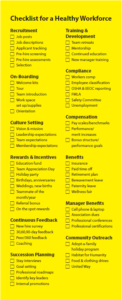Having been lucky enough to lead several clubs, I learned early on that there are many factors that determine a “healthy” club. No factor is more important than a “healthy workforce” and you can’t have that without an HR strategy. Every step in your club’s HR strategy needs to be well thought out—from finding the right people to join the team, to keeping them happy, motivated and engaged. For your strategy to be successful, it should be properly documented, culturized, and most importantly, reviewed/audited annually or biannually ensuring the plan’s efficacy and the club’s compliance.
Shirlene Industrious, director of human resources for The Club at Mediterra in Naples, Fla., and I developed an HR strategy working together years ago and it has grown and evolved thanks to her expertise. Together we have created a “Human Resource Strategy Check Up” that we believe will help you in the development, updating or auditing of your HR strategy. A strong focus on each of the areas in the checkup list increases your chances of having a healthy workforce. Each function is shaped through human capital, so your strategy must be excellent, and your execution must be even better. Here is to good health and an even healthier workforce.
- Recruitment: Hiring the best fit for the position and the club remains a top objective for success. Review and update job descriptions since responsibilities and/or requirements may have changed. Pre-hire testing and assessments are valuable tools in selecting the best candidate for the position.
- Onboarding: New employee orientation is not on-boarding! An effective on-boarding program introduces new employees to the club and their position in it, presents and reinforces club values and cultures, and clarifies the club’s expectations its new employees. On-boarding new teammates is critical to retention and it starts before their first day. Preparing for their arrival demonstrates that they are a valued part of your team.
- Culture Setting: Everyone is responsible for the culture in your club—the mission, vision, core values and expectations should be known and embraced. Culture setting begins during the recruitment process with candidate interviews and continues through onboarding and training.
- Rewards and Incentives: The appropriate mixture of rewards and incentives should match the club’s demographics. Seeking employee input and feedback allows the opportunity to revamp and create new programs with employee buy-in. Examining incentive distribution reports by department and managers will assist in identifying any unintentional gaps or biases when rewarding employees.
- Continuous Feedback: Feedback is critical; no employee should be surprised by a less than stellar performance review or improvement needed feedback. All employees want to know how they are doing; feedback gives them the opportunity to develop professionally. Coaching sessions with specific and measurable benchmarks are essential, but without follow-up, they are meaningless. Consistency in administering a progressive discipline policy will eliminate bias and clarify performance expectations. “Involuntary resignations” are accepted when it’s obvious that a good fit does not exist.
- Succession Planning: Conduct “stay interviews” with key employees identified for future promotion and growth within the organization. Developing a career road-map, with their input, is an important step to securing their future within the company. Identify any major skills, training or potential position gaps that exist, then initiate solutions to eliminate these gaps.
- Training & Development: Utilize an electronic system to track employee training, certifications and education levels. Offer a variety of training opportunities which can include internal credentialing, “lunch ‘n learn” sessions, webinars and outsourcing options. Investing in training keeps a club up-to-date on industry best practices in order to remain competitive.
- Compliance: Proactive risk management and compliance efforts should be club-wide. Risk management, safety committees and vendor partnerships are good resources to limit exposure to environmental and reputational risks. Management training at all levels is essential as these employees are often the first contact to be aware, reporting or responding to certain situations.
- Compensation: Pay and bonus structures tied to the club, department and professional goals are only effective if they clearly match these achievements. A pay strategy that is consistent fosters trust, minimizes bias and increases employee morale.
- Benefits: Don’t wait for open-enrollment time to review your benefits offerings. Insurance brokers can play an integral part of this process by providing a six-month check-up during your plan year. Find out if there are any unique benefits available to offer. Utilize professional peer relationships in a like club/organization to gather benchmarking information, ensuring your benefits remain competitive.
- Manager Benefits: Offering professional growth opportunities is a proven strategy in the recruitment and retention of key leaders. Investment in these benefits allows managers to stay on track and be prepared for the next level in their careers.
- Community Outreach: Giving back to the community assists in driving the values and culture of your club. Working together towards a goal for a good cause creates team bonding, memories and unity.
Thomas B. Wallace III, CCM, CCE, ECM is a partner of Kopplin Kuebler and Wallace, the most trusted name in private club executive placement and consulting. He can be reached at [email protected] or 412-670-2021.
Shirlene Industrious, SHRM-CP, PHR, is the director of human resources for The Club at Mediterra in Naples, Fla. She can be reached at [email protected] or 239-254-3002.



